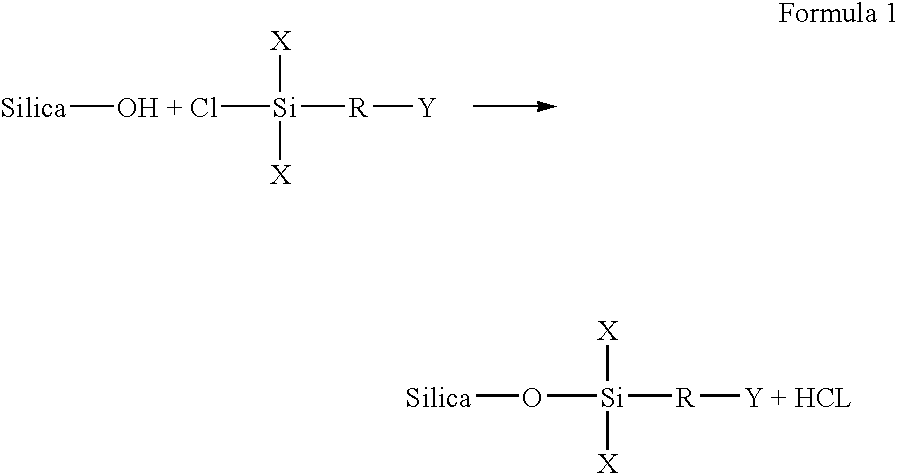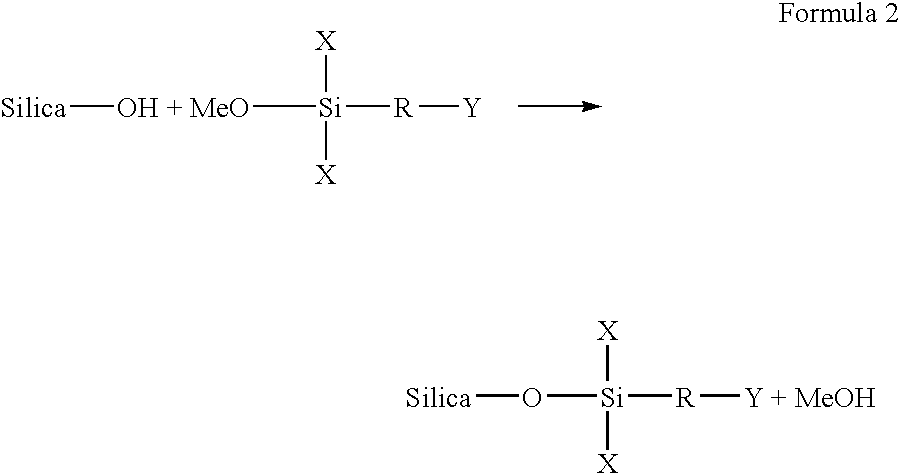Permanent fixation of dyes to surface-modified inorganic particulate-coated media
a technology of inorganic particulate coating and permanent fixation, which is applied in the direction of coating, inks, thermal imaging, etc., can solve the problems of affecting the coloration effect of dyes, the image created from water-soluble dye-based ink-jet ink compositions tends to fade over time, and the category of media is generally inferior in dry time and humid fastness relative to porous coated media, so as to improve water and moisture durability, effectively immobilize the coloran
- Summary
- Abstract
- Description
- Claims
- Application Information
AI Technical Summary
Benefits of technology
Problems solved by technology
Method used
Image
Examples
example 1
Preparation of Modified Silica with Reactive Group
[0064]In a reaction vessel, about 40 grams of silica to be modified is dried overnight in a vacuum at about 110° C. to remove the adsorbed moisture. The dried silica is then allowed to cool to room temperature. Next, about 500 ml of methanol is dried over calcium sulfate. The dried silica is then mixed with the dried methanol and the silica is dispersed in methanol by sonication or high sheer agitation. Dry nitrogen is then passed into the reaction vessel at a slow rate to eliminate ambient moisture. A halo silane reagent including an epoxy reactive group is then injected into the reaction vessel. The reaction mixture is then stirred at ambient temperature or refluxed. The amount of silane reagent used in the reaction is dependent on the surface area of the silica, the surface silanol concentration of the silica, and the functionality of the reagent. Once this process is complete, the product is then filtered. If excess reagent is us...
example 2
Preparation of Ink-jet Ink Composition
[0065]A blue ink-jet ink composition containing a dye reactive with the porous coating material prepared in Example 1 was prepared in accordance with Table 1 below:
[0066]
TABLE 1Ingredientwt %1,2-hexanediol11.5Dipropylene Glycol Monobutyl Ether0.5Tergitol 15-S-50.25Tergitol 15-S-70.25MOPS Buffer0.15EDTA (free acid)0.1Proxel GXL0.2Reactive Blue 152Water85.05
[0067]Reactive Blue 15 was selected as it includes an NH2 group that is reactive with the epoxy group present on the porous media prepared in accordance with Example 1. After printing the ink-jet ink of Table 1 one onto the media prepared in accordance with Example 1, the dye became covalently fixed to the modified particulates of the coating.
example 3
[0068]A red ink-jet ink composition containing a dye reactive with the porous coating prepared in Example 1 was prepared in accordance with Table 2 below:
[0069]
TABLE 2Ingredientwt %1,6-hexanediol92-Pyrrolidone4EDTA, Na salt0.1Proxel GXL0.15Tergitol 15-S-50.85Dowfax 2A10.32Acid Red 372Water83.58
[0070]Acid Red 37 (diammonium salt form from Aldrich, Catalogue No. 51,105-6) was selected as it includes an NH2 group that is reactive with the epoxy group present on the porous media prepared in accordance with Example 1. After printing the ink-jet ink of Table 2 onto the media prepared in accordance with Example 1, the dye became covalently fixed to the modified particulates of the coating.
PUM
| Property | Measurement | Unit |
|---|---|---|
| water-soluble | aaaaa | aaaaa |
| color | aaaaa | aaaaa |
| time | aaaaa | aaaaa |
Abstract
Description
Claims
Application Information
 Login to View More
Login to View More - R&D
- Intellectual Property
- Life Sciences
- Materials
- Tech Scout
- Unparalleled Data Quality
- Higher Quality Content
- 60% Fewer Hallucinations
Browse by: Latest US Patents, China's latest patents, Technical Efficacy Thesaurus, Application Domain, Technology Topic, Popular Technical Reports.
© 2025 PatSnap. All rights reserved.Legal|Privacy policy|Modern Slavery Act Transparency Statement|Sitemap|About US| Contact US: help@patsnap.com



